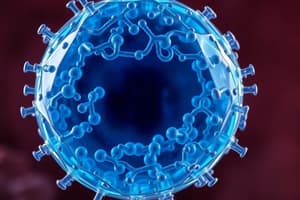Podcast
Questions and Answers
What is the primary function of the nucleus in a cell?
What is the primary function of the nucleus in a cell?
- To produce energy for cellular activities
- To synthesize proteins directly
- To serve as the storage for hereditary information (correct)
- To transport substances within the cytoplasm
Which statement accurately describes ribosomes?
Which statement accurately describes ribosomes?
- They are responsible for transporting proteins out of the nucleus.
- They produce both membranous and secretory proteins. (correct)
- They are involved in the synthesis of lipids.
- They function exclusively within the Golgi apparatus.
What distinguishes rough endoplasmic reticulum from smooth endoplasmic reticulum?
What distinguishes rough endoplasmic reticulum from smooth endoplasmic reticulum?
- Rough ER is primarily involved in lipid synthesis, while smooth ER is not.
- Rough ER functions in detoxification, while smooth ER does not.
- Rough ER lacks ribosomes and smooth ER contains them.
- Rough ER is associated with protein production due to the presence of ribosomes. (correct)
Which function is attributed to the Golgi apparatus?
Which function is attributed to the Golgi apparatus?
In the central dogma of molecular biology, which process directly follows DNA?
In the central dogma of molecular biology, which process directly follows DNA?
What are the three major parts of a eukaryotic cell?
What are the three major parts of a eukaryotic cell?
Which structure is unique to plant cells compared to animal cells?
Which structure is unique to plant cells compared to animal cells?
What does the fluid mosaic model describe?
What does the fluid mosaic model describe?
What characteristic of phospholipids helps them form a bilayer in an aqueous solution?
What characteristic of phospholipids helps them form a bilayer in an aqueous solution?
What role do transport proteins play in cellular function?
What role do transport proteins play in cellular function?
Flashcards are hidden until you start studying
Study Notes
Nucleus
- Acts as the control center of the cell, housing genetic material.
- Stores hereditary information vital for protein synthesis.
- Each gene is a unique DNA sequence that encodes a specific protein.
- Surrounded by a double membrane known as the nuclear envelope.
- Nuclear pores regulate material passage between the nucleus and cytoplasm.
Ribosomes
- Small, dot-like structures found on the rough endoplasmic reticulum or within the cytoplasm.
- Produced in the nucleolus, located within the nucleus.
- Key role in protein synthesis, translating genetic information into proteins.
Central Dogma of Molecular Biology
- Describes the flow of genetic information: DNA transcribes to RNA, which then translates to protein.
Endoplasmic Reticulum (ER)
- Major site for synthesizing a wide range of cellular molecules, structured as a network of tubules and sacs.
- Divided into rough and smooth types based on ribosome presence.
Rough Endoplasmic Reticulum (RER)
- Characterized by ribosomes, which give it a "rough" appearance.
- Synthesizes membranous and secretory proteins, which are then transported via vesicles.
Smooth Endoplasmic Reticulum (SER)
- Lacks ribosomes and is involved in lipid synthesis, including steroids and detoxification processes.
Golgi Apparatus
- Known as the cell’s shipping and receiving center; refines, stores, and distributes cellular products.
- Identified after scientist Camilo Golgi.
Eukaryotic Cell Structure
- Composed of three primary regions: plasma membrane, nucleus, and cytoplasm.
- Plasma membrane regulates molecular traffic; nucleus is the gene-containing organelle; cytoplasm encompasses organelles and cytosol.
Plant vs. Animal Cells
- Plant cells possess chloroplasts for photosynthesis and cell walls for support; animal cells do not.
Cell Membrane
- Functions as a barrier to separate living cells from nonliving surroundings.
- Comprised mainly of phospholipids, cholesterol, and proteins, following the fluid mosaic model.
Fluid Mosaic Model
- Describes the membrane's structure, which allows movement and flexibility due to the arrangement of phospholipids and proteins.
Phospholipid Bilayer
- Composed of amphipathic phospholipids with hydrophobic tails and hydrophilic heads, forming a double layer in aqueous environments.
Selective Permeability
- Membranes selectively allow certain substances to cross while blocking others using specialized transport proteins.
Lysosomes
- Membrane-enclosed sacs filled with digestive enzymes responsible for breaking down macromolecules.
- Function as the cell’s digestive system, processing both ingested material and worn-out cellular components.
Vacuoles
- Membranous sacs that serve various functions depending on cell type—small in animal cells, larger in plant cells for water balance and waste storage.
Chloroplasts
- Organelles in plants and some protists that conduct photosynthesis; contain multiple compartments for various functions.
Mitochondria
- Known as the powerhouse of the cell, involved in cellular respiration, converting sugars into ATP, which is usable energy for the cell.
Cytoskeleton
- Functions as both a supportive skeleton and muscles for cellular movement, maintaining cell shape through microtubules made of tubulin proteins.
Studying That Suits You
Use AI to generate personalized quizzes and flashcards to suit your learning preferences.




